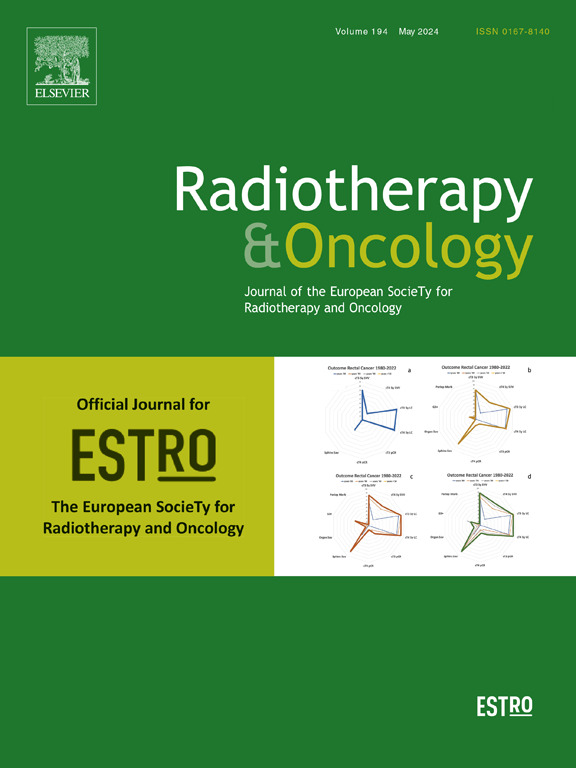Kinetics of PSMA PET signal after radiotherapy in prostate cancer lesions: A single-center retrospective study
IF 4.9
1区 医学
Q1 ONCOLOGY
引用次数: 0
Abstract
Purpose
To evaluate the kinetics of prostate-specific membrane antigen (PSMA) PET uptake in irradiated lesions using serial PSMA PET/CT scans.
Methods
Patients with prostate cancer who underwent 68Ga-PSMA-11 PET/CT before (PET1) and after radiotherapy (PET2) were retrospectively included. Percentage changes in SUVmax (ΔSUVmax) of the irradiated lesion were measured. The presence of residual uptake was visually assessed on PET2. When available, follow-up imaging was used for lesion validation. Morphologic or uptake disappearance on follow-up scans was defined as loco-regional complete response (L-CR). Clinical and PET characteristics were compared between lesions with and without residual uptake. An optimal timing for response assessment was calculated by receiver-operating-curve analysis.
Results
Eighty-nine patients with 217 irradiated lesions (106 lymph nodes, 85 bone, 21 prostate/prostate bed) receiving ablative radiotherapy were included. Lesion uptake was lower at later time points and was lowest at 9–12 months after radiotherapy. Sixty-eight lesions showed residual uptake on PET2. Residual uptake was more common in lesions imaged at an earlier time point after radiotherapy (median: 7.9 vs. 13.0 months, p = 0.001), lesions in the prostate/prostate bed (p < 0.001), and lesions with higher baseline SUVmax (p = 0.001). Thirty-one residual uptake-positive lesions had available follow-up imaging, of which 24 lesions were confirmed to be L-CR. Risk factors for not achieving L-CR were lesions with prolonged uptake (p = 0.002) and those in the prostate/prostate bed (p = 0.003). The optimal time point for predicting L-CR was 8.6 months.
Conclusions
Timing and tumor site affect the PSMA PET signal after radiotherapy, and should be considered when assessing response on post-radiotherapy PSMA PET.
前列腺癌放疗后PSMA PET信号动力学:单中心回顾性研究。
目的:通过PSMA PET/CT连续扫描,评估前列腺特异性膜抗原(PSMA) PET在辐照病变中的摄取动力学。方法:回顾性分析放疗前(PET1)和放疗后(PET2)行68Ga-PSMA-11 PET/CT检查的前列腺癌患者。测量照射后病变的SUVmax (ΔSUVmax)百分比变化。在PET2上目视评估残余摄取的存在。如有可能,随访影像学用于病变验证。形态学或摄取消失的随访扫描被定义为局部-区域完全缓解(L-CR)。比较有无残留摄取病变的临床和PET特征。通过接受者-工作曲线分析,计算出反应评价的最佳时机。结果:89例接受消融放疗的患者共217例,其中淋巴结106例,骨85例,前列腺/前列腺床21例。病灶摄取在后期时间点较低,在放疗后9-12 个月最低。68个病变在PET2上显示残留摄取。残留摄取在放疗后较早时间点成像的病变中更为常见(中位数:7.9 vs. 13.0 个月,p = 0.001),前列腺/前列腺床病变(p )结论:放疗后PSMA PET信号影响时间和肿瘤部位,在评估放疗后PSMA PET疗效时应考虑时间和肿瘤部位。
本文章由计算机程序翻译,如有差异,请以英文原文为准。
求助全文
约1分钟内获得全文
求助全文
来源期刊

Radiotherapy and Oncology
医学-核医学
CiteScore
10.30
自引率
10.50%
发文量
2445
审稿时长
45 days
期刊介绍:
Radiotherapy and Oncology publishes papers describing original research as well as review articles. It covers areas of interest relating to radiation oncology. This includes: clinical radiotherapy, combined modality treatment, translational studies, epidemiological outcomes, imaging, dosimetry, and radiation therapy planning, experimental work in radiobiology, chemobiology, hyperthermia and tumour biology, as well as data science in radiation oncology and physics aspects relevant to oncology.Papers on more general aspects of interest to the radiation oncologist including chemotherapy, surgery and immunology are also published.
 求助内容:
求助内容: 应助结果提醒方式:
应助结果提醒方式:


